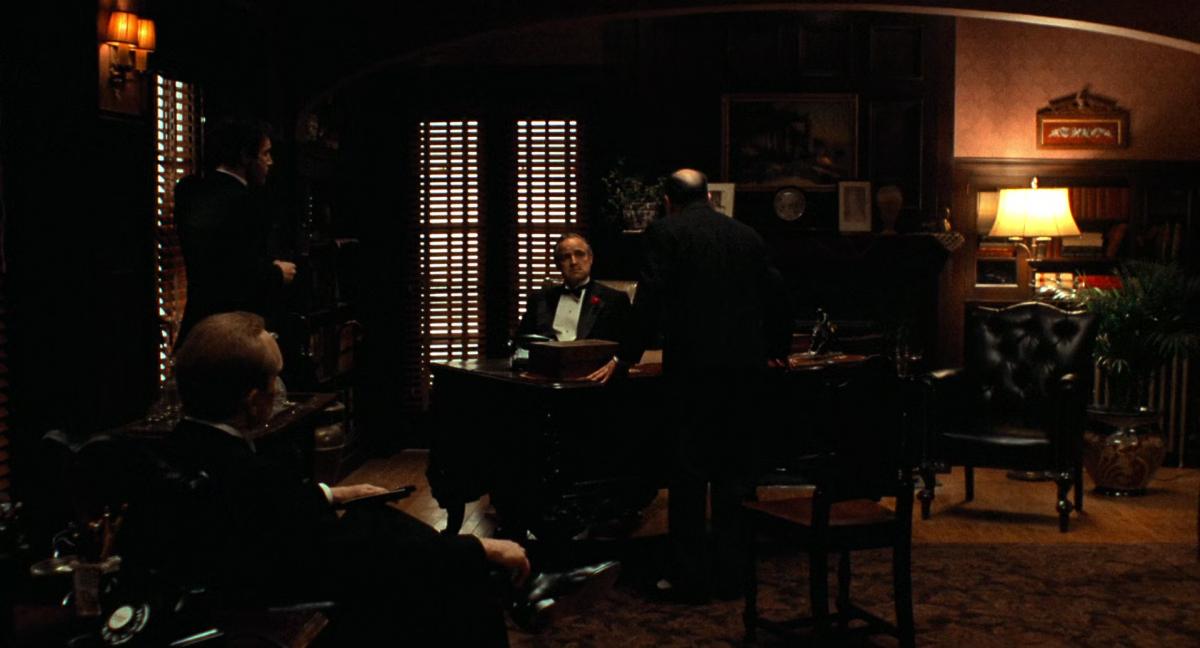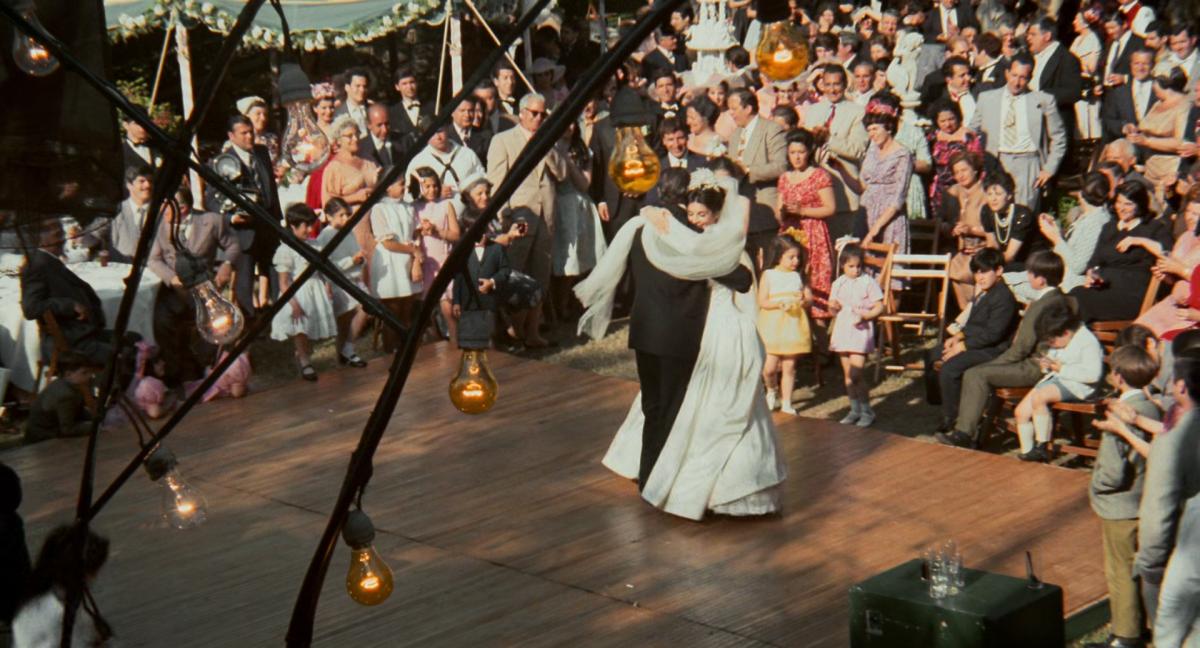The Godfather

Everything you’ve heard and read about The Godfather is simultaneously true and false. It’s a gangster film and then again not a gangster film. It’s a reconstruction, a period piece, and then again not.
It’s an imitation of earlier cinema, but when asked of which cinema exactly, you don’t get much further than “earlier cinema”. Marlon Brando is magnificent in the film, and yet, who is this Marlon Brando? It’s a clever story, but upon closer scrutiny, you sense weaknesses everywhere. For three hours, you live under the spell of a film and you start thinking you’ve lived under the spell of “cinema” (finally real cinema again, people thought). But can you keep up “cinema” with a single “real” film every few years? Do people still know what “cinema” is? And if they spontaneously identify The Godfather with real cinema, isn’t that a distorted kind of remembrance?
It’s hardly surprising that so many film critics, in their first paragraph about The Godfather, write that “so much has already been written about the film” and that they “do not feel like joining in the chorus”. Wim Verstappen does so in Vrij Nederland (7 October 1972), Richard Roud in The Guardian (6 April 1972), John Russell Taylor in The Times (22 August 1972), Sarris in The Village Voice (16 March 1972). What I liked best was Peter van Bueren’s formulation in De Tijd (29 September 1972): “The Godfather is like a wonder of the world about which you have read everything, which you finally get to see, about which you utter a few clichés from a tourist guide on your return, and about which it is hard to say anything meaningful.”
Audiences don’t really know what to make of this successful film either. And that’s quite understandable because real success is always made by the audience itself. A successful film is elected by popular acclaim. I remember hearing a radio interview with a woman who had seen West Side Story more than sixty times when it came out. Now that’s a contribution to making a film a success! But The Godfather was a success already before any audience got involved.
Like Love Story, The Godfather is mostly a success of clever publicity. Clever? Efficient in terms of revenue, maybe, but to me it feels like exhaustion. A couple more of those amped up successes and the last bit of film pleasure is gone for good, everyone realising that the success is programmed and not made by the audience.
A film that is not at all what it claims to be at face value, a success that is not actually a success, an audience that is merely programmed. A puzzle that never really fits together and which everyone nonetheless claims to form a nice pattern. All the pieces are there, but the figures on it do not form a whole. Everything is wrong, the nose to the feet, the hands to the head. And yet you think, what a beautiful hand and what beautiful eyes!
So I loved The Godfather very much. More than most people I spoke with, who all felt a bit frustrated. They complained about colours not being right, about the film’s duration and slowness. All details, I felt, that were indeed debatable but missed the point of the film. Although I really loved the film on an emotional level – I sat and watched Marlon Brando with bated breath – I did have enough distance to immediately question that loving, or rather, to feel that I would find it hard to make clear why I loved the film.
One of the functions of publicity for modern success films is that you are immediately handed a detailed vocabulary in which to formulate your preferences and enthusiasm. They do not only recommend a certain product, they also suggest a certain way of consuming of it. You might have to drill through that when watching the film. Not an easy thing to do.
For me, The Godfather has nothing, absolutely nothing, to do with mafia, banditry, gangsters; with a political parable; with the well-known “detective film” genre; with the 1940s or with the cinema of the time. These all seem to me to be excuses and manoeuvres meant to avoid addressing the core fascination of the book and film.
The emotional core, the driving force of the entire phenomenon, is the patriarchal family structure, the biblical dimension of the story. It is a family film, many people noted, but they forgot to add that it is a very unusual family film.
Women, for instance, do not play a significant role in the novel or the film, while American family films are inconceivable without female characters. What’s more, family films never lack an American-variant guerre des sexes, a disturbing variant because it never papers over the voice and presence of the feminine. Women are there, and it’s hard to reach a livable and sensible compromise with them. Look at The Godfather: there is no guerre des sexes, because women don’t count. Or rather, The Godfather shows the Latin variant of the guerre des sexes, where war may flare up now and then but whose arrangements have long since been tried and socially institutionalised.
Women are so unimportant in The Godfather that, for instance, Appollonia can be blown up in Sicily without agitating the audience one bit. The same indifference when Connie gets beaten up by Carlo. Besides, in the novel, the depersonalised nature of nearly all women is even more evident (save Kay perhaps, but then again, she is non-Italian, non-Latin).
A men’s film, then? If so, not the American men’s film we used to admire in war films, westerns and detective films. Men’s films brimming with irony, ambiguity, with the playfulness of latent homosexuality, the self-irony with which they are described as escape films: escape from women, from the guerre des sexes, from the family structure. The Godfather is a men’s film, but it is not about and with “men-among-men” but about and with “a father and his sons”, about legacy, tradition and duty. Real American men’s films and family films have in common that the relationships between people are spontaneous and accidental. The relationships are “open” relationships. People come from different places, have different histories, different desires and tastes. The encounters between people are chance encounters: on the street, at work, in a bar. The beauty of these films is how that coincidence is developed, the creative way in which that coincidence is employed emotionally and dramatically. Quite a contrast with The Godfather: a closed family clan, in hedgehog position against the outside world. Only inward solidarity, not towards the outside world and not, therefore, to life. The characters and family structure are not oriented towards experience but towards repetition.
Such closed and aggressive family clans have been seen before in American films. Maybe every American family film is partly about that. But there is always something to counterbalance that closeness. It is approached as a problem, as a social disease. Kazan, for instance, repeatedly portrayed closed families, but his films are not family films but painful and problematic films, brimming with conflict and bad conscience.
The Godfather is not a film with conflicts that spread to the audience. It is not a problematic but a very naive film. I just wonder what naivety might mean in the year 1972.

Images from The Godfather (Francis Ford Coppola, 1972)
This text originally appeared in Kunst & Cultuur, no. 22, 1972.
This translation was published by courtesy of Reinhilde Weyns and Bart Meuleman.
With the support of LUCA School of Arts, LUCA.breakoutproject.

